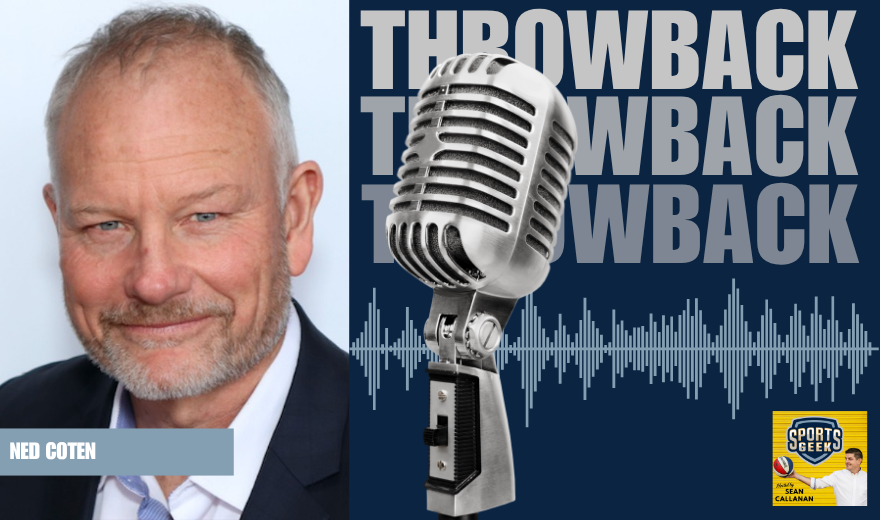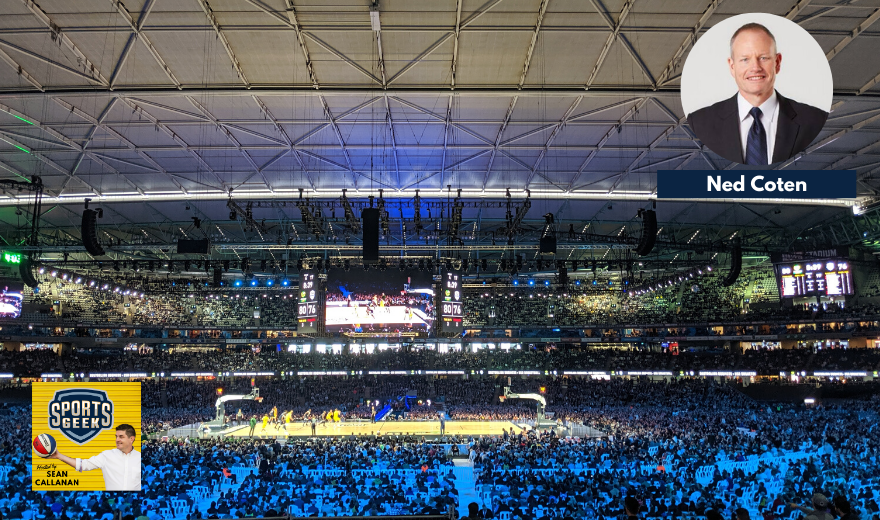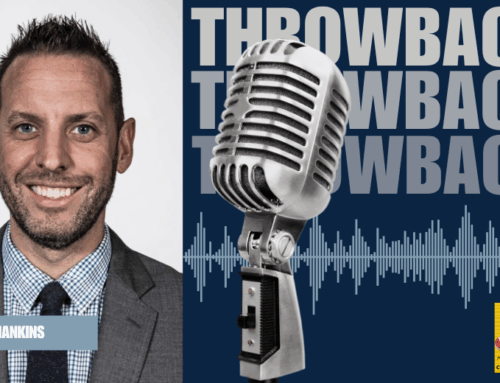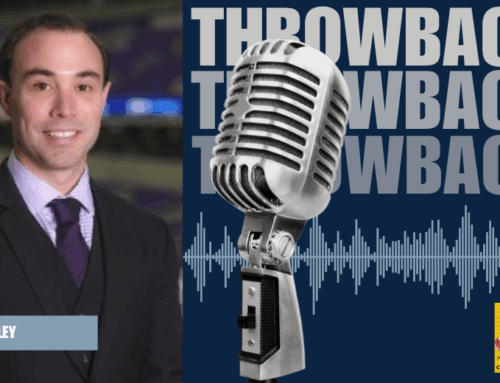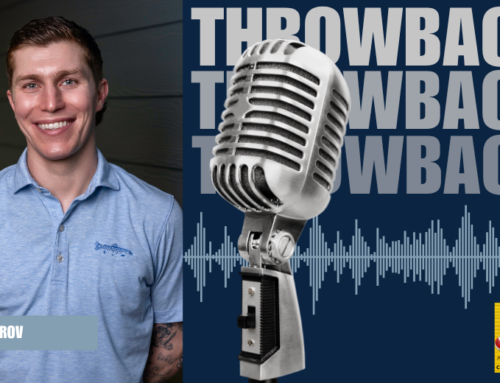In this Sports Geek Throwback episode, Sean Callanan interviews Ned Coten from episode 256
Can't see podcast player? Click here to listen
Key Takeaways
In this Sports Geek Throwback,Ned and Sean discusses:
- The success of Australian basketball is built on a 50-year foundation of grassroots development, driven by volunteer coaches and community leaders across the country
- The NBL's revitalisation under Larry Kesselman's leadership has created a stronger domestic professional pathway
- Australia's basketball infrastructure has evolved from worrying about league survival to managing unprecedented facility demand, with Victoria alone requiring over 100 new courts
- Strategic partnerships with NBA Asia and the establishment of the NBA Global Center of Excellence in Canberra demonstrate Australia's growing influence in global basketball
- The sport's growth is attributed to a combination of strong domestic leagues (NBL, WNBL) and international exposure through the NBA and European leagues
Sean: And so, basketball in Australia is in a really healthy spot. So what's the remit for Basketball Australia? Because that has changed over the six years you've been at Basketball Australia. What's the remit now?
Ned: Yeah, look, it's a really great question, Sean, and it's evolving at the moment, is probably the easiest way or the best way to describe it.
I think I. Four year, and we're just going through this process at the moment. But four years ago we had a strategic plan from 2016 until 2020 to take us basically through the sort of Olympic periods. It's traditionally how NSOs such as BA or the national sporting organizations such as Basketball Australia have operated.
And if you think back to 2016 in Australian basketball, it was a time when the NBL was on its knees. The Board of Basketball Australia was, one of the questions I guess we asked was, will there be an NBL? The NBL had broken away from basketball Australia, or had separated from basketball, in a good way, but was really struggling.
Larry Kesselman was a team owner at that stage. The other owners convinced Larry to invest in the league and take it over and we now see the incredible job that Larry's done in rebuilding that league. So that's been a fundamental change to the environment in Australian basketball.
We have also seen a number of other changes in that Australian players now are getting really high profile roles in the NBA, the WNBA in Europe. And so I think that a lot of Australian kids have always, there's been an undercurrent of support for basketball. And a lot of that is actually the NBA.
And so if you ask a kid on the street, do you follow basketball? Yes. Who's your favorite player?
Sean: Yeah.
Ned: LeBron, Steph Curry, they're NBA players, but I think Larry's done a great job of really invigorating the NBL and the women's NBL operates under basketball Australia.
And I think we're now doing a reasonable job of building that league as well. And so, as you say, Sean, the whole infrastructure and the whole profile of the sport has lifted and it's been a bit of a perfect storm. A lot of different things have happened, and I'm a very strong believer that the success that we're experiencing at the moment is based on the last 30, 40, 50 years of.
Grassroots basketball in this country. So the volunteer coaches in country stadiums or country courts, like the one I grew up on, and I still remember my coach, John Stone was a local school teacher. He was very influential in my life and my basketball career. And he was a volunteer. He just came out, he coached, he refereed, he really did an incredible job.
And there were people like that all over the country. And there have been for the last, at least 50 years in Australia, and here in Victoria where I now live, people like Betty Watson, and Lindsey Gaze and many, many thousands of others have just over the years just been constantly involved in the sport.
And so you've now got this massive base of participants, of people that love the game and have learned the game the right way. And so when you have that massive base over a 40 or 50 year period, we now have reached that level where there's so many athletes, so many administrators, so many referees.
It's not just players on the world stage. It's others as well. And so that's a result of 50 years of work, not five years of work.
Sean: No, it's not just the golden generation of these guys have made the NBA, they're doing it on the shoulders of the other players who've gone before them that made the small breaks, Luke Longley and those kind of things being first draft picks and those kind of things.
And those early eighties and nineties. Building on that success of the NBL? Yeah, it's amazing because it is coming from Matthew Dellavedova playing in Maryborough to playing in the NBA. And so it's a good problem to have for basketball to be going, how do we connect these kids with these guys?
It's very similar to what FFA faces with the Socceroos. Like, you've got these talented guys all over the world, and I think Jeremy and Larry, the guys at the NBL are doing a good job of trying of connecting the NBL, the NBA guys and the whole basketball scene to be aspirational. If I'm playing, if I am playing, I can end up at the NBA is a pathway, which is.
The bread and butter of basketball Australia, but then this entertainment product that we've got these superstars that are playing in the biggest league in the world.
Ned: Yeah, look, that's exactly right. And you know, as you and me were sort of joking at the start, we go down to Sac in Melbourne on a Tuesday morning from seven to eight, and anyone listening who's a half decent players, welcome to join us at that time.
We're all old hacks, but we've got plenty of back chat and it's a lot of fun. But what we see down there is on the half court and all the courts are full. And they're full with kids that are playing with coaches, running either development programs or one-on-ones.
There's people down there that are really doing an incredible job to build the sport. And we see that all over the country, six or seven o'clock in the morning. There's kids on basketball courts. And when I was a kid, that didn't happen. And so the world has really changed as you've said, and I think that it's a combination of the NBL, the WNBL, the NBA, the women's NBA, what's happening in Europe.
The sport globally is really booming. It's really going well. I would argue that the NBA, probably along with Premier League Soccer is the best run and operated and certainly the most visible league in the world. And so we're a recipient of, or a beneficiary of that excellence that they're doing.
And we have, in fact, just before getting on this chat with you, I was just talking to someone out of NBA Asia who we've got a very close relationship with. We have a very close relationship with the NBA in the US, the NBA have invested in the Australian Institute of Sport in our global Center of excellence.
So there's an NBA Global Center of Excellence in Canberra, run in conjunction with the AIS program where athletes from all over the world really come and develop because Australia is seen as such a stronghold of development, of talent, of young talent. And so I think that that's an incredible change.
So, to go back to that sort of strategic plan. The foundation on which we're standing is totally different. To just four years ago. And that's a fantastic spot to be in. And so what we have is we've got higher level issues now that we've got, before we worried about will we have a league, will we be able to play?
And now thinking, well, how do we cope with this demand? The biggest issue that the sport faces in Australia is a lack of facilities. We don't have enough facilities to cater for. Not future demand. Current demand. So there's, right at the moment in Victoria, we need over a hundred courts to cater for existing demand in addition to what we've already got.
And those courts are being filled from seven in the morning on a weekend till 10 at night, Saturday, Sunday, and every night of the week. And some of those are 16 court facilities.


